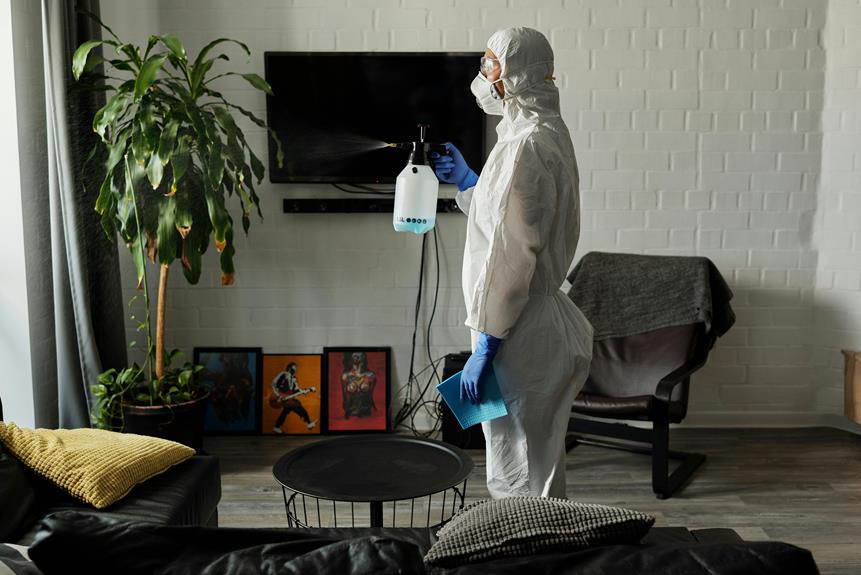Your TV aerial might not be working due to loose connections or damaged cables. Check to make sure all connections are secure and inspect both the port and cable for wear. Positioning is essential; ensure your aerial points directly towards the transmitter without obstructions. Signal interference from nearby electronics or communication towers can also cause issues—filters might help there. Test your aerial with another TV to rule out device-specific problems. Inspect the aerial for physical damage or corrosion. If these checks don't resolve the issue, you might find more detailed troubleshooting steps useful.
Key Information
- Check for loose or damaged aerial connections and cables.
- Ensure the TV aerial is correctly positioned towards the transmitter.
- Inspect the aerial for physical damage, corrosion, or wear.
- Identify and minimize sources of signal interference.
- Test the aerial with another TV or device to confirm functionality.
Check Aerial Connections
Start by confirming that the TV aerial is securely plugged into the back of your TV to avoid any potential signal loss. Check for any loose connections or damaged cables that might be affecting your aerial's performance. Use a flashlight if necessary to inspect the port and cable for any visible wear or damage.
If the cable appears frayed or the connector looks bent, replace them immediately. Tighten any loose connections by gently but firmly securing them. It's also a good idea to verify that the aerial is correctly configured to your TV's input settings.
Inspect Aerial Positioning
To guarantee the best signal reception, check if the TV aerial is properly positioned and free from obstructions that might block its line of sight to the transmitter. Use a compass to accurately point the aerial towards the nearest transmitter location. Adjust the direction as needed to optimize reception and minimize interference. Make sure the aerial is securely mounted and positioned correctly.
| Task | Tool | Purpose |
|---|---|---|
| Check aerial positioning | Visual inspection | Identify any obstructions |
| Point aerial to transmitter | Compass | Ensure accurate alignment |
| Adjust aerial direction | Hands/Adjustable mount | Optimize signal reception |
| Verify secure mounting | Screws/Bolts | Maintain proper orientation |
Assess Signal Interference
Analyze potential sources of interference by examining nearby transmitters, communication towers, and electronic devices that might disrupt your TV signal.
Start by identifying:
- Communication Towers: Tetra, 4G, and 5G frequencies from nearby towers can interfere with your TV broadcasts. Use a filter to block these frequencies.
- Physical Obstructions: Buildings, trees, and temporary structures may obstruct signals. Reposition your aerial to a higher location to bypass these barriers.
- Electronic Devices: Household electronics, power lines, and neighboring wireless equipment can cause interference. Make sure your aerial uses integrated balun aerials and double-screen cabling to minimize these effects.
Test With Another Device
When troubleshooting your TV aerial, it's crucial to test it with another TV or device to pinpoint the source of the issue. Start by connecting the aerial to a different TV and see if the signal improves.
You can also use a signal meter to check the aerial's functionality on this alternate device. Look for any interference that might be blocking the signal and make sure there are no device-specific issues affecting performance.
If the second TV receives a clear signal, the problem likely lies with your original TV. Confirming signal reception on another device will help you identify whether the aerial or the TV needs further troubleshooting, allowing you to take the next appropriate steps.
Examine Aerial Condition
After confirming the issue isn't with your TV, it's time to examine the aerial's condition for any physical damage or wear.
Start by inspecting the aerial components thoroughly. Look for signs of corrosion or rust, which can hinder signal reception. Also, check for loose or disconnected parts that might disrupt the connection.
Here's a checklist to guide you:
- Physical Damage: Examine the aerial for bent or broken elements.
- Corrosion: Check for rust on metallic parts, which could affect signal quality.
- Secure Mounting: Verify the aerial is firmly mounted and correctly aligned.
If your aerial shows significant wear and tear or damage, replacing it might be the best solution to restore your TV signal quality.
Consider Professional Help
Sometimes, seeking professional help is the most effective way to diagnose and fix complex TV aerial issues. Qualified technicians have the expertise to resolve problems efficiently and accurately. They guarantee correct installation and alignment, which is essential for excellent reception. Experts can recommend the best aerials based on your location and signal strength, providing thorough and detailed solutions.
Here's a quick comparison to help you decide:
| DIY Approach | Professional Help | Benefits |
|---|---|---|
| Limited troubleshooting | Thorough diagnosis | Accurate issue identification |
| Trial and error adjustments | Proper installation/alignment | Excellent signal reception |
| Basic equipment knowledge | Expert recommendations | Suitable aerial selection |
| Temporary fixes | Long-lasting solutions | Reliable TV viewing experience |
| Personal time investment | Time-efficient service | Convenience |
Hiring professionals saves you time, effort, and ensures quality results.
Frequently Asked Questions
Why Is My TV Aerial Not Picking up Signal?
Make sure your aerial cable's securely connected to your TV. Verify the correct input source. Check if the amplifier's on. Retune your TV. Inspect wall-plates, coaxial cables, and the aerial itself for faults.
Why Does My TV Say No Signal When Antenna Is Plugged In?
Check if your aerial cable connections are secure. Confirm your TV is set to the correct input/source. Inspect the amplifier and power supply units. Retune your TV. Examine the aerial for water damage that could cause signal loss.
How Do I Know if My Aerial Is Faulty?
Check for physical damage, water damage, or corrosion. Test the aerial on another device. Confirm it's pointing correctly. If issues persist, consult a professional aerial installer for a thorough assessment and possible replacement.
Why Will My TV Not Pick up Channels?
Confirm the aerial's properly connected and the TV is set to the correct input/source. Retune your TV to scan for available channels. Check for aerial damage, positioning issues, and possible interference or obstructions disrupting the signal.
Conclusion
If your TV aerial's still not working after checking connections, positioning, and for signal interference, try testing with another device.
Inspect the aerial's condition for any damage.
If all else fails, it's a good idea to contemplate professional help. A qualified technician can diagnose and fix issues that DIY methods might miss.
Don't let a faulty aerial ruin your viewing experience—take these steps to restore your TV signal efficiently.



